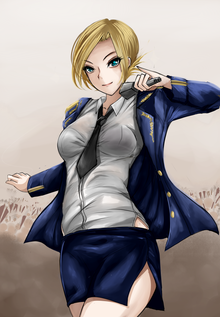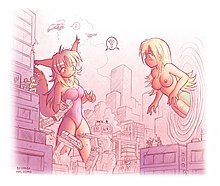Ecchi
Ecchi (エッチ, in katakana?, pronounced etchi), is a Japanese slang word that adopts the "H" from the word hentai (変態, '' hentai''? pervert) from the Latin alphabet to refer to lewd conduct.
- As an adjective, it has the meaning of "mañoso", "lascivo" or "sexy", similar to iyarashii (ら, obscene?Cash.
- As a verb, ecchi suru (▪, do etchi?)It has the meaning of having sex.
- As a noun, it is used to describe someone who looks lusty, is similar in meaning to Zero (, Erotic?) but does not imply perversion as the word does hentai.
Concept in the anime
The word ecchi has been adopted by anime fans to describe works with sexual overtones. In Japan, the word ecchi is often used to describe a person's behavior, but in fandom it is used to refer to softcore or playful sexuality, as opposed to the word hentai which already connotes an advanced degree of perversion or fetishism. Works described as ecchi do not show sexual intercourse or genitalia. But the sexual theme is hinted at, leaving the rest to the viewer's imagination. A theme of ecchi is fan service, and can be found in the shōnen manga/anime comedy, seinen and harem.
Etymology
The concept ecchi comes from the Japanese word hentai (変態, perversion ?), referring to behavior related to flagrant or very ardent and passionate sex. From the moment Ebing's book Psychopathy of Sex (1903) is translated and published in Japan under the title Hentai Seiyoku Shinri (変態性欲心理, Psychology of sexual perversion?) (1914) in Japan, sexology boomed, and several magazines and books were published with the word hentai.
- In 1996, in an interview with Shimada Shinsuke ( ك の , Shimada Shinsuke?) (at 80), he said that the term Hentai came out since he was in primary school, and hence Hentai's "H" was changed by ecchi.
- In the Meiji Era, the initial "H" of English husband Argot was used in a sexual sense by women from secondary schools and university students in the late nineteenth century.
- In the Taishō Age and early Shōwa Era, it represented homosexuality among women with the English argot "H" Hen.
- It became popular in 1952 with its use in a novel published by Seiichi Funabashi.
- In the 1990s, it was used as a substantive and verb to refer to the sexual act itself.
- The spread of this term is often credited to comedian Sanma Akashiya.
Other theories
- The most common theory asserts that it derives from the first letter of the word hentai and, in fact, the two words have similar meanings (although the word hentai cannot be used to refer to sexual intercourse nor can it be used as a verb.
- The "H" is the first letter of the word Harenchi (▪, shameless?), a word that means "sluggish" or "dead."
- The first letter in himitsu (2020), a Japanese word meaning "secret".[chuckles]required]
- The letter H is the letter between the G and the I. The word jii (NET,, which is read as the English lyric "G", means masturbation and the word "Ai" (women), which is read as the English lyric "I", means love).[chuckles]required]
- The letter "H" is the first letter hentaithat by just saying "H" means lit. pervert.
- The most complicated theory could be that it comes from a key word used by the soldiers of the Japanese Imperial Navy to refer to the word sukebe (folding), which means obscene. The first letter (ST) comes from the word tasukeru (plus oneself, meaning "help"), this, translated into English, would be helpfrom which the first letter is taken.[chuckles]required]
Uses
Japanese Usage
Ecchi, as an adjective, can be translated as obscenity or attractive, while as a verb it can be translated as sexual intercourse. Making ecchi (ecchi suru) would mean having sexual intercourse. The word sekkusu (sex) is also used in Japan to refer to sex, and native Japanese words such as seikō (性交) are often replaced by words of foreign origin such as sekkusu (sex) or neologisms such as ecchi.
A person who is overly interested in sexual gratification is called sukebe (助平). Sukebe is also a general term denoting lasciviousness, which loses its definition, overlapping somewhat with the meaning of the word ecchi.
The nuance of ecchi varies depending on the context, but in general the word itself is comparable in English to the words "mischievous" or "dirty" (when used as an adjective). The prefix "h-" is sometimes used to refer to genres of pornographic material: h-anime, h-manga, etc.
Western usage
In Spanish, the term was often based on manga and anime. The term is applied to manga and anime ecchi that have a slight sexual content (such as skimpy clothing and/or partial nudity), but do not show full sexual intercourse. However, ecchi has historically often been used synonymously with hentai, presumably due to confusion of the two. Therefore, it can carry different connotations than what is allowed by the Japanese original. In recent years its use by English speakers has been largely reoriented with the Japanese sense H, although it has become a completely separate term, including all of the above.
The word ecchi in their native language is used for "sex/pornography" and hentai to describe someone "kinky" and these two meanings are interchanged in western usage, so in the world of anime and manga ecchi also describes those works that have a strong presence of perversion, both in the story and in the characters themselves., being indifferent to the fact that it presents the characteristics described above, since these correspond more to fanservice. One of the few examples of the latter is the Seitokai Yakuindomo anime and manga for presenting a story solely focused on perversion but without any of the typical characteristics mentioned above.
Typical examples
There are many possibilities when classifying a work as ecchi, but these elements have to occur very often (for example, in all episodes of an anime).
Typical features include:
Nudity
Graphically speaking, different techniques are used to display sexy images, usually by revealing parts of the female body. It varies strongly between works, due to the intended audience and the preferences of the authors, if the level of nudity and appearance is excessive it should be classified as fan service.
Some of these recurring patterns are:
- Scenes of a shower or fighting scenes in which clothing breaks through weapons, magic or simple struggle. Whether on the back, gluteos or even breasts and panchira (situation where a woman's inner garment is visible).
- The imagination of the characters is also a common excuse to show nakedness.
- Scenes of transformation of the magic girls.
- Occasional nudity (in the female case it includes breasts), but the genital area is not shown or used in the panchira.
- Few clothes, swimsuits with lines that show the crotch (sometimes cameltoe) and the sides of the breasts.
- It is also used to describe a semi-denizen person.
In the end, any excuse is valid to show a partially or completely naked character.
Censorship
Due to Japan's censorship law passed in July 2011, nudity of any kind cannot be shown on broadcast television. It is acceptable on home video, but at no time (including pornography) may genitalia be shown.
Nosebleeds
A typical reaction to nudity is nosebleeds, which stands for extreme blushing as in Baka to Test to Shōkanjū and Maria † Holic. where the characters almost "die" due to heavy blood loss or in Dragon Ball Master Roshi's nose bleeds.
Pantsu
The visibility of underwear, such as panties, is a common reason. It often leads to strange reactions between a woman and the male lead, who accidentally (or not) look at the underwear. The reaction can be very varied, depending on the color and style of the pantsu, but usually the man is punished for looking, regardless of the reason. The color and style of the pantsu is not chosen at random. Both are seen as an indicator for the character of the woman. Innocent women wear white or kawaii panties with hearts or similar motifs, shy girls prefer (striped panties) Shimapan; in some cultures red is seen as "the devil" or "bad", etc.
The same theme pantsu is so popular, that it is an important item in anime like Chobits or Sora no Otoshimono. Coincidentally, four episodes of any anime rely on the pantsu theme as a narrative element. The anime Panty & Stocking with Garterbelt goes one step further, where the pantsu is used as a weapon or combat strategy. But even if the pantsu is not the main theme itself, it often shows up due to "careful choice" of the camera angles. In this case, it can legitimately be called fan service, since it's not necessary for the story itself.
Situations and postures
Articles of clothing in which the shape of the breasts, nipples and genital lips (cameltoe) are outlined, which suggests pressure from the clothing and the consequent arousal.
- Uniforms, dresses and suits adjusted or that can be provocative, but used as daily clothes by the character.
- The clichés commonly used in the anime as the "head on the bust", when a male character knows a girl with an exaggerated bust and by some situation ends with the sunk face among his attributes.
- Characters that are not aware of their sexuality seem innocent and joyful, or cunning and naughty.
- Clothing that is being withdrawn, in particular bathing suits and school uniforms, "marinero" style.
- Images of underwear seen when the skirt or neck is lifted.
- Exaggerated sexual attributes, often in normal characters or in chibi to generate contrast. Especially used in dōjinshi and fanartwhere a character can appear more sexualized than normal.
- Lind and innocent or with obvious sexual characters in behavior or clothing.
Sexual intercourse
Normally, there is no sex in manga or anime classified as ecchi. Such works are classified as hentai. The ecchi will always leave the rest to the viewer's imagination.
- Silhouettes that seem like a couple had sex, for example, the silhouette outside a tent when they are most often doing something completely innocent.
- Sounds or groans suggesting that a couple is in full sexual act, when in most cases it is for something non-sexual.
- Suggestive or phallic images, such as Japanese mayonnaise bottles.
- Situations in which there is an apparent sexual position resulting from some kind of accidental occurrence. The anime To Love-Ru is well known for making use of this kind of situations.
- A scene court in which one understands that the couple have had sex.
The ecchi style of art is little comparable to that of pin-up girls in a suggestive attitude, or sexual provocation in American and other fantasy and comic book art. countries.
Contenido relacionado
Paraguayan national anthem
Planet of the Apes (1968 film)
Chilean folklore



